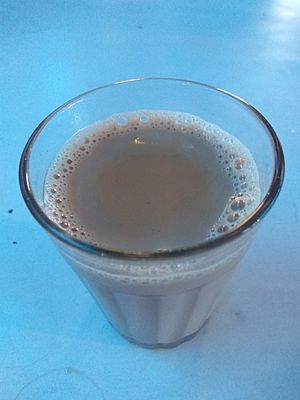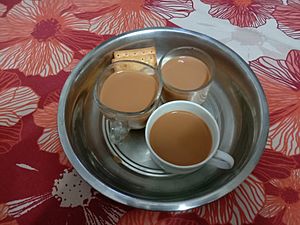Milk tea facts for kids
Milk tea is a popular drink that mixes tea and milk. It can be served hot or cold. People often add different spices or sweeteners like sugar or honey.
Milk tea is a common way to drink tea in many countries, especially in South Asia. In places like India and Pakistan, it's often called Chai. But in countries like England and Ireland, people usually drink tea without milk, which is called 'black tea'. You can even find instant milk tea powder that's made in factories!

Contents
History of Milk Tea
Where Did Tea Drinking Begin?
Tea plants were first grown in the Indian subcontinent in the Assam hills when Britain ruled India. In Britain, drinking tea became popular among rich people in the late 1600s. They learned this habit from the Dutch and Portuguese. At first, people thought tea was good for health. Slowly, it became a common drink for everyone in Britain.
Even though India is famous for its tea today, the idea of drinking tea every day didn't start there. Many experts believe that tea drinking began in China. It was first used as a medicine and later became a popular drink.
India knew about tea leaves and their health benefits, but they didn't drink it regularly. After exporting tea to Portugal, Japan stopped. This meant China controlled the world's tea trade. But China didn't want to share its secrets about growing tea. To solve this, British spies went to China and secretly took tea plants. These plants were brought to India and grown in Darjeeling. By the 1850s, Darjeeling tea became very famous, even called the 'Champagne of Teas'. From then on, Indian tea became a big part of the global market.
How Was Tea Discovered in Assam?
Tea was first found in Assam by Mr. Robert Bruce in 1821. This happened during the Burmese war. He supposedly brought tea plants and seeds with him. The first tea plants were discovered in upper Assam.
Assam tea was sent all over India, and many farmers made a living by selling it. When tea was found there, European planters invested money in Assam. This made Assam richer than other parts of India. In 1834, the Indian government created a tea committee to try and grow more tea in Assam. This first plan didn't work out. But in 1838, the Bengal Association was formed with both Europeans and Indians who wanted to expand tea growing.
After some tough first years, tea farming started to get much better around 1852. By this time, there were 15 tea gardens in Sivasagar, covering about 400 acres. The tea grown was worth a lot of money. Over the next three years, tea production grew very fast.
What is the Milk Tea Alliance?
The Milk Tea Alliance is an online group of people from Thailand, Hong Kong, Taiwan, and Myanmar. They support democracy and stand together. This group started because of Chinese internet users who would post negative comments online. The Milk Tea Alliance now speaks up for better democracy in their own countries.
Milk tea became a symbol for this group. They believed that people in their countries usually drink tea with milk, while in China, tea is often drunk without milk. (Even though China actually has a long history of drinking milk tea too!) Australia has also been linked to the Milk Tea Alliance, but their connection to milk tea is not as strong.
The "Milk Tea Alliance" name became popular in 2020. This happened after Chinese internet users criticized a Thai actor named Bright. He had 'liked' a picture on Twitter that called Hong Kong a "country". People then called for his TV show to be boycotted. But Twitter users in Taiwan, Hong Kong, and the Philippines joined Thai users to show support. This was a rare moment of countries in the region standing together. After some border disagreements between China and India in 2020, India also joined the Alliance. Their special milk tea is called masala chai.
Pallabi Munsi, a writer for OZY, described the Milk Tea Alliance as "Asia's volunteer army rising against China's internet trolls."
Different Kinds of Milk Tea
There are many different types of milk tea around the world:
- British tea: Tea served with milk, which is how most tea is drunk in the United Kingdom.
- Bubble tea: Also known as pearl milk tea or boba milk tea. This drink from Taichung, Taiwan, has chewy tapioca balls at the bottom.
- Burmese milk tea (laphet yay cho): Made with strong black tea and sweetened with condensed milk and evaporated milk. It's popular in Myanmar.
- Cambric tea: A sweet, hot milk drink, often with a little bit of tea.
- Hong Kong-style milk tea: Black tea sweetened with evaporated milk. It started during the time when Britain ruled Hong Kong.
- Doodh pati chai: This means 'milk and tea leaves'. It's a tea drink enjoyed in India, Pakistan, Nepal, and Bangladesh.
- Teh tarik: A type of milk tea popular in Malaysia and Singapore. The tea is 'pulled' between two cups to make it frothy.
- Suutei tsai: A salty Mongolian milk tea.
- Shahi haleeb: A Yemeni milk tea.
- Masala chai: Also called masala tea, this is a spiced milk tea from the Indian subcontinent. It has spices like cardamom and ginger.
- Irani chai: A type of milk tea made with pure milk mixed with mawa (a milk solid). It's prepared in Iranian-style cafes in Hyderabad, India.
- Thai tea: A sweet tea drink popular in Southeast Asia.
- Royal milk tea: A product invented by the Lipton tea company in Japan in 1965.
- Dalgona milk tea: Milk tea sweetened with traditional Korean dalgona, which is a honeycomb-like candy.
In Britain, when hot tea and cold milk are mixed, it's simply called tea. This is because most tea there is drunk this way. The term milk tea is not commonly used.
pl:Bawarka
See also
 In Spanish: Té con leche para niños
In Spanish: Té con leche para niños


